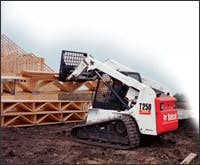Equipment superintendent Dwight Cook is happier than a pig in mud and making a whole lot less mess thanks to utility crawlers. "I'm tickled to death with them," says Cook, a 24-year construction-industry veteran who rents utility crawlers partly for their ability to float across soft, muddy construction areas.
Now working as an equipment consultant for College Station, Texas-based R.M. Dudley Construction, Cook says that in some applications, utility crawlers cut production time in half when compared to rubber-tire skid-steers. The track's larger surface area creates more down pressure and provides more might for moving dirt. "Grade work is ten times faster," he says. The undercarriage's lower center of gravity gives operators more pulling, pushing and lifting ability. Utility crawlers also offer less ground pressure—some less than three psi—so operators don't tear up the work site.
Attachments traditionally used on skid-steers are more effective on utility crawlers, say operators. While working to tear down interior walls during a building demolition, Cook found his grapple-equipped utility crawler had more "grab and drag" to remove large chunks from tangled debris. Utility crawlers so impressed Cook, he bought one for the company. "They're sweet. My operators love them," he says.
Cook's comments signal a growing appreciation for utility crawlers that is also reflected in rapidly rising equipment sales. Within 10 years, utility-crawler sales have jumped from next to nothing to 7,500 units in 2002, according to machinery-market researcher Chuck Yengst, Yengst Associates, Wilton, Conn. Yengst expects 2003 utility-crawler sales reports to hit 9,000 units and says that number may climb as high as 14,000 in a few years. "They're taking off like gangbusters," says Yengst.
Still, utility crawlers have barely made a dent in the rental market where their big brother, the skid-steer, still rules supreme. Rental companies buy about 60 percent of the roughly 60,000 skid-steers sold annually in North America, say analysts. By contrast, only about 10 percent of the utility crawlers sold each year make it into rental shops, says Frank Manfredi, Machinery Outlook publisher and equipment market consultant, Manfredi & Assoc., Mundelein, Ill. Higher purchase and maintenance costs may be keeping rental shops from making the investment, he adds. They may also be one of the reasons rental customers are requesting them.
"We rent them because we tear them up," says J.T. Woods, assistant operations manager, Geopier Foundation Co-West, Hillboro, Ore. Geopier rents utility crawlers primarily for cleaning up and grading around aggregate piers where the ground is typically wet and unstable. Utility crawlers are "more connected to the ground," says Woods, giving the operator more pushing power and stability. Before finding utility crawlers, Woods typically rented a skid-steer equipped with steel tracks. A cost comparison convinced him that utility crawlers offered a bigger bang for the buck.
Utility crawlers rent for $2,250 a month, while a comparable steel-track-equipped skid-steer runs $1,950 monthly, according to Woods. "[The skid-steer] is a little cheaper, but the [utility-crawler] benefits outweigh the cost," he says. "We're definitely getting more productivity." Steel tracks wrapped around wheeled skid-steer tires present additional hassles, he adds. "The tracks are usually too loose and the tires spin inside them." Rubber tracks attached to rubber tires don't fare much better, says Yengst. "The tracks slip and don't give you traction. The undercarriage system is a much better idea."
But tracks have their limits. Most manufacturers recommend staying off concrete, asphalt and other hard surfaces. And areas strewn with debris and broken-up concrete and rebar can wreak havoc on tracks, tearing them up and dismantling them. Although the same can be said of tires, replacing the track suspension can cost more than three times as much as changing out tires. The increased production and versatility of tracks for use in wet and harsh conditions mitigates the higher maintenance costs, says Cook. "It's going to cost me more, but I can keep the job running in more conditions," he says.
On Cook's recent demolition project, tracks eliminated downtime suffered when rubber tires inevitably took a nail and required replacing on site. Utility-crawler manufacturers say users can expect to replace rubber tracks every 1,200 to 1,600 hours under general applications such as digging and backfilling. Cook says his new machine suffered a failure at around 900 hours. "I'm running it in a really harsh setting," he adds.
Utility crawlers will become more attractive when the track life justifies the additional maintenance and acquisition costs of the machines, says Cook. Utility crawlers cost roughly $10,000 more than comparably equipped and powered skid-steers. Rental shop owners may continue to balk at the difference until customer demand increases and prices drop.
That will happen as more competitors enter the small but increasingly more populated utility-crawler market. Five years ago, a handful of manufacturers offered one or two models hovering around the 65- to 75-hp range. Now, about a dozen CTL makers are offering more options ranging from 30-hp units that can be towed behind a station wagon to models pushing more than 105 hp. Lifting capacities range from about 800 to 3,000 pounds.
"As market quantities go up, [utility crawler] component costs will go down," says Manfredi. That may encourage more rental shop owners to take the plunge.
While few are saying that utility crawlers will replace the mighty skid-steer in the rental market, many believe utility crawlers will give skid-steers a crawl for their money. Adds Yengst: "It's just a matter of time."




